
The Virtual Boy is a 32-bit tabletop portable video game console developed and manufactured by Nintendo. Released in 1995, it was marketed as the first console capable of displaying stereoscopic "3D" graphics. The player uses the console like a head-mounted display, placing the head against the eyepiece to see a red monochrome display. The games use a parallax effect to create the illusion of depth. Sales failed to meet targets, and Nintendo ceased distribution and game development in 1996, having released only 22 games for the system.

Earthworm Jim 2 is a 1995 run and gun platform video game and the sequel to Earthworm Jim, and the second and final game in the Earthworm Jim series developed by original creators Doug TenNapel, David Perry, and Shiny Entertainment. It was released in late 1995 and early 1996 depending on region and video game console, initially being released for the Sega Genesis and Super Nintendo Entertainment System, before being ported to other platforms.
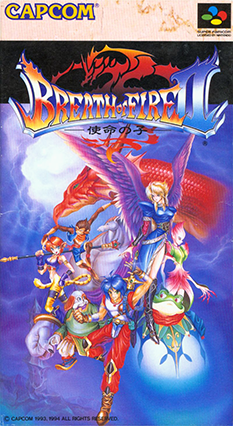
Breath of Fire II is a role-playing video game developed and published by Capcom. First released in 1994, the game was licensed to Laguna for European release in 1996. It is the second entry in the Breath of Fire series. It was later ported to Game Boy Advance and re-released worldwide. The game was released on Wii's Virtual Console in North America on August 27, 2007. Nintendo of Europe's website mistakenly announced it for release on July 27, 2007, but it was in fact released two weeks later, on August 10, 2007. In 2013, it was released for the Wii U Virtual Console. In 2016, it was released for the New Nintendo 3DS Virtual Console. In 2019, it was released for the Nintendo Switch SNES games library.

Mario's Tennis is a 1995 sports game developed by Nintendo for the Virtual Boy video game console. The game was released at the launch of the Virtual Boy, and later as a pack-in game in North America.

Red Alarm is a 1995 shoot 'em up video game developed by T&E Soft and published by Nintendo. Released as a Virtual Boy launch game, it requires the player to pilot a space fighter and defeat the army of a malevolent artificial intelligence called KAOS. The game takes inspiration from the 1993 title Star Fox, and it is one of the few third-party titles for the Virtual Boy. Unlike most of the console's games, Red Alarm features three-dimensional (3D) polygonal graphics. However, hardware constraints limited the visuals to bare wire-frame models, similar to those of the 1980 arcade game Battlezone. Reviewers characterized Red Alarm's graphics as confusing, but certain publications praised it as one of the most enjoyable Virtual Boy titles.

Kirby's Dream Course is a 1994 miniature golf video game developed by HAL Laboratory and Nintendo EAD and published by Nintendo for the Super Nintendo Entertainment System (SNES). A spin-off of the Kirby series and the first released for the SNES, players control the pink spherical character Kirby through a series of courses by launching him towards the goal hole at the end. Kirby can hit enemies to collect power-ups that grant him unique abilities, such as those that allow him to destroy certain obstacles or fly around the level.

Mario Clash is a video game produced by Nintendo in 1995 for the Virtual Boy. It is the first stereoscopic 3D Mario game, and a 3D reimagining of Mario Bros. Reception for the game was mixed.
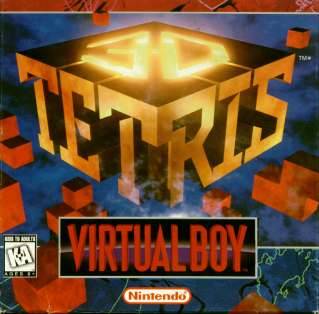
3D Tetris is a 1996 puzzle video game developed by T&E Soft and published by Nintendo for the Virtual Boy. It was released on March 22, 1996, in North America. Players control multiple falling blocks, rotating and positioning them to clear layers in a three-dimensional environment similar to Tetris's gameplay. The game contains multiple modes and variations thereof, as well as different difficulty settings and levels. Parts of 3D Tetris are rendered as 3D wire-frame models. A version of the game entitled Polygo Block was set for release in February 1996 in Japanese markets, but was never released. The game received mostly negative reviews with critics panning it for a lack of originality.

Virtual Boy Wario Land is a platforming video game developed and published by Nintendo for the Virtual Boy game system in 1995. It stars Wario, a treasure hunter who must find treasure and fight enemies to progress. Wario can jump and charge with his shoulder as basic techniques, and equip special hats to gain things such as fire breathing and bull horns. He has the ability to enter the background at certain points, making use of the console's stereoscopic 3D effect. It was developed by Nintendo R&D1, containing a large portion of its staff, and features the red-and-black color scheme that is standard for Virtual Boy releases.

Mario's Picross is a 1995 puzzle video game for the Game Boy. Developed by Jupiter and Ape and published by Nintendo, it is a compilation of nonogram logic puzzles. The game stars Mario who chisels away at puzzle grids to form pictures. The game initially received positive reviews, with reviewers citing its length and addictive nature as a positive, but its grid sizes and absence of typical Mario elements as a negative.

Galactic Pinball is a pinball video game for Nintendo's Virtual Boy game console. The game was released on July 21, 1995 in Japan and on August 14, 1995 in the United States. It is set in the Milky Way galaxy, and has players maneuvering a puck around one of four pinball tables available in the game. The Virtual Boy's standard red-and-black color scheme resulted in criticism of this and other games on the platform for causing nausea, headaches, and eye strain. It uses parallax, which allows the game to display three-dimensional effects. It has received a mixed reception; it was praised for its authenticity, while reception to its physics and controls were mixed. It has received criticism for its lack of ambition and originality.
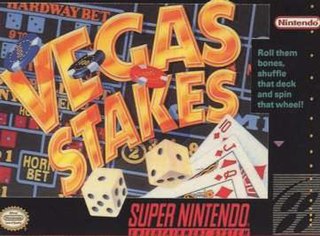
Vegas Stakes, known as Las Vegas Dream in Japan, is a gambling video game developed by HAL Laboratory and published by Nintendo for the Super Nintendo Entertainment System in April 1993 and for the Game Boy in December 1995. The Super NES version supports the Super NES Mouse, while the Game Boy version is compatible with the Super Game Boy, and features borders which use artwork from the SNES version. It is the sequel to the NES game Vegas Dream.

Golf is a golf-based sports simulation video game developed and released by Nintendo in 1984 for the Famicom in Japan. Later the same year, it was ported to the Nintendo VS. System as VS. Golf or Stroke and Match Golf, released in arcades internationally, followed by another arcade version called VS. Ladies Golf. The original was re-released for the NES in North America in 1985, and for the Famicom Disk System in 1986 in Japan.
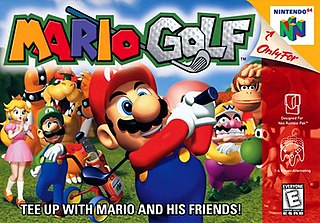
Mario Golf is a 1999 sports game developed by Camelot Software Planning and published by Nintendo for the Nintendo 64. Mario, his friends, and his enemies play golf on a variety of Mario-themed courses. Following NES Open Tournament Golf, it is the second game in the Mario Golf series. Camelot also developed a Game Boy Color version, which adds role-playing elements.

Vertical Force is a 1995 vertically scrolling shooter video game developed and published for the Virtual Boy by Hudson Soft in Japan and by Nintendo in North America. The player controls a starship, the Ragnarok, that must destroy a malfunctioning supercomputer on a human colony planet before it wipes out all of mankind. Gameplay is similar to Hudson's Star Soldier series, featuring power-up items that increase the player's abilities and parallax scrolling. The player can move their ship farther into the background to avoid enemies and obstacles in the way.

Bomberman: Panic Bomber is a 1994 puzzle video game developed and published by Hudson Soft for the PC Engine on December 22, 1994. It was later released for the Neo Geo, Super Famicom, Sharp X68000, FM Towns, NEC PC-9821, Virtual Boy, and PlayStation Portable. It saw a re-release for the Wii and Wii U's Virtual Console services. Panic Bomber is a falling block game with the players' goal being to clear matching blocks using bombs, ensuring that their screen does not fill and that their opponents' screens do. It received mixed to positive reception, identified as a decent game by multiple critics. It has been compared to the falling block puzzle game Tetris. The Virtual Boy version received a mixed reception for its handling of the platform's visual capabilities.

Waterworld is a series of video games released for the Super Nintendo Entertainment System, Virtual Boy, MS-DOS, Microsoft Windows and Game Boy, based on the film of the same name, along with unpublished versions for the Mega Drive/Genesis, Sega Saturn, Atari Jaguar, 3DO and PlayStation. These games were produced by Ocean Software. The SNES and Game Boy games were released only in Europe in 1995 and the Virtual Boy game was released exclusively in North America in November 1995. It was released for PC in 1997. The game received widespread negative reviews and the version released for the Virtual Boy is generally considered to be the worst game of its 22 releases.

Virtual League Baseball is a 1995 baseball video game developed and published by Kemco for the Virtual Boy. A sequel, Virtual League Baseball 2, was planned, but later canceled due to the Virtual Boy console's poor sales.
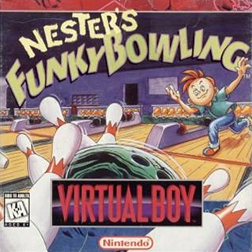
Nester's Funky Bowling is a bowling video game developed by Saffire and published by Nintendo for the Virtual Boy console. It was only released in North America on February 1996, and was the second-to-last game released for the system before it was discontinued. Players control Nester, a character from the Nintendo Power comics, or his twin sister Hester, as they compete to see who is the superior bowler. It features standard bowling mechanics and rules, and has three modes of play - Bowling, Challenge, and Practice, all three supporting one or two players.

V-Tetris is a 1995 puzzle video game developed by Locomotive and published by Bullet-Proof Software in Japan for the Virtual Boy. Its gameplay involves the player clearing horizontal lines by moving pieces of different shapes that descend onto the playing field by filling empty spaces in order to make completed lines disappear and gain points across three modes of play.




















